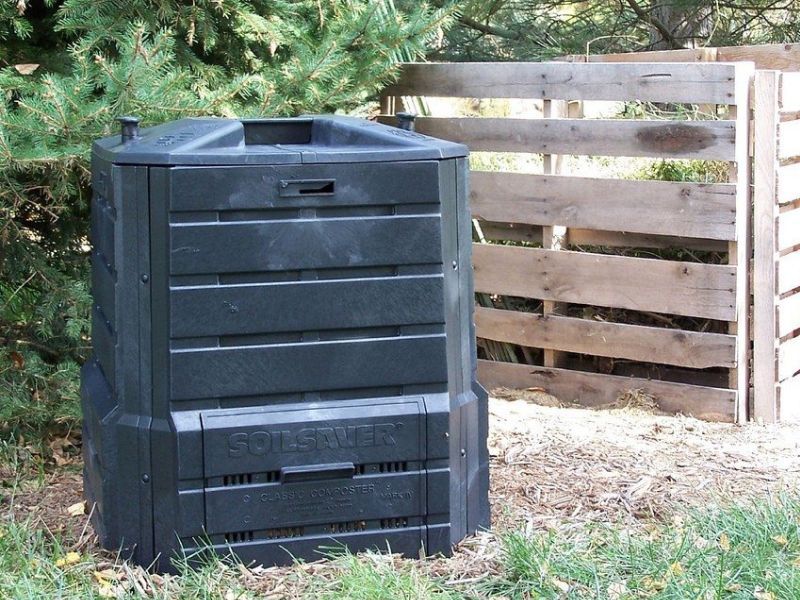Easy Ways to Rat and Critter-Proof Your Compost Bin

A common misconception and one we are often asked about is whether composting will attract rats. Rats are quite prevalent in San Diego, particularly roof (or tree) rats. Palm tree and other dense vegetation (bougainvillea, honeysuckle) provide ideal habitats. Food is often supplied from fruit trees, vegetable gardens, and bird feeders.
It is important to note that composting will not encourage pest populations to move into your area, though a neglected pile may attract local populations and make them more visible to you. Studies have shown that pests, including rats, were the third most common composting obstacle—following lack of space and lack of knowledge. Pest problems should not be underestimated, but there are a few simple measures that can help to keep pests from getting in or being interested in your compost pile. The best solution is prevention! Pest-proofing your bin can prevent animals from tunneling up through the bottom, climbing into the bin from the sides or top, or chewing holes in the bin. Below are some tips:
- Use hardware cloth to line the bottom and outside walls of your bin. For mice, 0.5 cm (1/4 in), 16 gauge should be used; 1 cm (1/2 in), 20 gauge for keeping out larger pests. (Hardware cloth is galvanized wire mesh, available at most home improvement/hardware stores. Chicken wire is not a good protection against unwanted visitors).
- Get a tight-fitting lid or modify your existing lid by adding hinges and a latch. Or stretch a bungee cord or chain across the lid and fasten it to the sides of the bin. A heavy brick or rock will also keep the lid secure.
- Pile rocks or bricks around the outside bottom edge of your bin as a good measure against burrowing animals.
- Alternatively, you could consider purchasing a rodent-proof bin that is already fitted with such deterrents.
- Covering all food scraps is your best defense! When adding food scraps, dig a hole in the center of the pile. Then, add alternating layers of nitrogen and carbon (aka Lasagna Composting), always ending with a carbon layer, which serves as a blanket and keeps flies from laying eggs on the exposed nitrogen material, and masks the odor of food waste from other animals. Placing materials that are high in carbon (i.e., dried leaves) at the bottom of the pile and along the inside walls of your compost bin will provide good airflow, drainage and odor control. It is also important to harvest finished compost at the bottom of the bin every three to six months. This will discourage pests from nesting in the warm finished compost.
- It is also recommended to not add meat, cheese, or leftovers containing excessive oil or seasoning. These creatures are attracted to meats, fatty foods, and cooked foods, so it is best to exclude these from your bin or pile. These animals are also looking for other food sources (i.e., bird feeders, outdoor pet food bowls, garbage cans, and fruit trees). It is a good idea to position your compost bin away from these other food sources and nesting locations! Good compost management can deter pests while also accelerating the composting process. By being mindful of what you put in your compost bin and how you manage it, you may prevent these unwanted visitors. Every time you aerate or turn your compost pile the temperature increases, which will both speed up decomposition but also deter these animals that are looking for a dry, cool, undisturbed home and food source.
- For composting projects in areas where rodent activity is high—the use of fully enclosed bin systems may be your best option. If using an open pile, it is especially important to fully cover, or cap, any active compost piles with a biolayer: at least 2 inches of finished compost, at least 6 inches of unscreened compost, or 12 inches of wood chips, to avoid attracting rodents.

Deny Habitat
- Enclosure – fully enclosed bins, particularly tumblers.
- Raise bin off ground (for burrowers).
- Place bin on a concrete or sand base.
- Hardware cloth – use to place under bin and/or line bin.
- Reduce clutter.
- Properly store feedstock and/or garbage.
- Rats are attracted to prior rodent infestation, using urine as an attractant. You may need to power wash hard surfaces to remove signs of rat activity.
Deny Security
- Rats don’t like open spaces. Keep compost bins away from a fixed wall or fence.
- Don’t create harborage (safe shelter). Dense vegetation often provides rat habitat.
- Rats only need a space the size of a quarter to gain access. Find and seal all external holes in garages and sheds to keep rodents from getting in. Use rodent-proof materials: ¼ inch 18-22 gauge wire hardware cloth.
Deny Food
- Avoid composting meats and oils.
- Bury fresh food waste 6 inches deep (open pile system).
- Cover with finished compost (open pile system).
- Properly store feedstock and/or garbage. Don’t leave birdseed and pet food out at night.
- If your yard has fruit trees, nuts or vegetable gardens, make sure you pick food as it ripens. Don’t leave fallen fruit or vegetables lying on the ground.
- Encourage predators (owls, hawks).
The use of poisonous bait is never recommended because it can endanger the lives of pets and other wildlife. The use of glue traps is just plain cruel.
For more info or questions specific to your property, call our rotline at (760) 436-7986 ex. 700.
